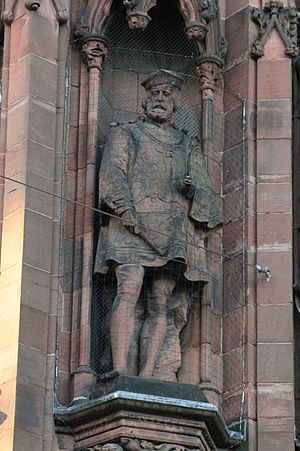David Lyndsay facts for kids
Sir David Lyndsay (born around 1486, died around 1555) was an important Scottish knight, poet, and a special kind of official called a herald. He became the top herald in Scotland, known as the Lyon King of Arms. Lyndsay is still remembered as a great poet. His writings show the ideas of the Renaissance, a time of new art and learning. He was also known as a "makar", which is an old Scottish word for a poet.
Contents
About David Lyndsay

David Lyndsay was born in Scotland, probably in Fife. We don't know exactly where or when he went to school. He might have studied at the University of St Andrews around 1508.
He worked for the royal family as a courtier. First, he was an equerry, which meant he looked after horses. Then, he became an usher for the young Prince James. This meant he helped with the future King James V of Scotland's education. Lyndsay's poems often gave advice to the young king.
Around 1522, Lyndsay married Janet Douglas. She worked as a seamstress at the royal court.
Lyndsay's Important Jobs
Lyndsay's first job as a herald was Snowdoun Herald. In 1529, he became the Lord Lyon King of Arms, the highest heraldic position in Scotland. He was also made a knight.
As Lord Lyon, he helped with important events and ceremonies. He helped organize the celebrations when King James V married two French princesses: Madeleine of Valois in 1537 and Mary of Guise in 1539.
Lyndsay also traveled for Scotland as a diplomat. He went to the Netherlands and France on official business.
After King James V died in 1542, Lyndsay continued to serve Scotland. He was a member of the Parliament of Scotland for Cupar, Fife. In 1548, he was part of a group sent to Denmark. They worked to get special rights for Scottish merchants. It is believed that Sir David Lyndsay died around 1555.
Lyndsay's Heraldic Work
In 1542, Lyndsay created a special book called the Lindsay of the Mount Roll. This book contains 400 Scottish coats of arms. A coat of arms is a unique design that represents a family, person, or group. This book is still very important today. It forms the basis for the official Scottish heraldic records.
He also prepared another important book called the Register of Scottish Arms. This book is kept in a library and is a key document for Scottish heraldry. Heraldry is the study of coats of arms and family histories.
Lyndsay's Literary Works
Most of Lyndsay's famous poems were written when he worked at the royal court. He was known for being able to speak freely. He often criticized all parts of society, from the king to ordinary people.
Even though he was Catholic, he openly pointed out problems and unfair practices within the church. People who wanted to reform the church found his work very helpful. His poems helped spread their ideas for many years.
Lyndsay's Longer Poems
- The Dreme (a long poem with 1134 lines)
- The Testament and Complaynt of the Papyngo (1190 lines)
- The Historie and Testament of Squyer Meldrum (1848 lines)
- Ane Dialog betwix Experience and ane Courteour of the Miserabyll Estait of the World (6333 lines)
- Ane Pleasant Satyre of the Thrie Estaitis (a play with over 4000 lines).
Arms
 |
|
See also




